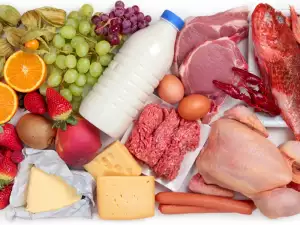Folic acid, or vitamin B9, also called folate or folacin is a B-complex vitamin, known for its great importance in pregnancy and prevention of defects in pregnancy. These defects include malformation of the fetal structure, called the neural tube.
Vitamin B9 is a water soluble vitamin that was first extracted from spinach. Vitamin B9 was named from the Latin folacin, which translates as leaf. For the best source of this vitamin are considered green leafy vegetables with large green leaves. Vitamin B9 is essential for the formation of red blood cells.
Folic acid is one of the most chemically complex vitamins, with a three-part structure that places special demands on the body's metabolism. The three main components of folic acid are PABA, glutamic acid and pteridin.
Most foods contain folic acid in the exact form described above, and intestinal enzymes alter the chemical forms of folates to make their absorption possible. Even when the body is functioning at full efficiency, only about 50 percent of incoming dietary folate can be absorbed.
Functions of folic acid
- Supports the formation of red blood cells and circulation - one of the key functions of folic acid as a vitamin is to allow for full development of red blood cells.
They help transport oxygen around the body. In folic acid deficiency, red blood cells do not form properly and continue to grow without division. This condition is called makrocitic anemia.
Folic acid also helps maintain healthy blood circulation in the body by preventing the accumulation of a substance called homocysteine. By reducing high levels of homocysteine, folates protect against the development of osteoporosis.
- Cell production - cells with very short life (such as skin cells, intestinal cells and cells that are visible on the body surfaces or cavities) are highly dependent on folic acid for their creation. Therefore, folate deficiency leads to problems in these tissue types. In the mouth, these problems are associated with inflammation of the gums and palate and periodontal disease.

In the skin, the most common problem of this type is seborrheic dermatitis. The loss of skin pigment ( vitiligo ) can also be associated with folic acid deficiency. Cancers of the esophagus and lung, uterus and cervix, bowel (especially the colon) are also frequently associated with folate deficiency.
- Nervous System Support - prevention of neural tube defects in newborns is only one of the nervous system functions of folic acid. Folate deficiency is associated with a wide range of problems of the nervous system, including general mental fatigue, senile dementia, depression, restless leg syndrome, problems with the hands and feet, irritability, forgetfulness, confusion and insomnia.
Overdose of folic acid
Taking very high doses of folate, higher than the 1, 000 to 2, 000 micrograms, can activate the same types of symptoms related to the nervous system that it is usually used for preventing.
The Institute of Medicine of the National Academy of Sciences of the United States has set permissible limit for folate intake of 1000 micrograms for men and women over 19 years of age. This limit should apply only to "synthetic folate" - forms of folate derived from supplements and / or fortified foods.
Folic acid contained in animal products (such as beef liver) was relatively stable during cooking, unlike folate contained in products of plant origin (such as cabbage), which can lose up to 40% of their content in cooking. For its part, processed cereals and flours can lose up to 70% of their folate content.
Drugs that can impair the body's supply of folate include: cancer drugs such as methotrexate, cholesterol-lowering drugs such as cholestyramine; inflammatory drugs such as sulfasalazine, and also drugs such as buformin, fenformin or metformin used to treat diabetes, even birth control pills.
Benefits of Folic Acid
Folic acid may play an important role in the prevention and / or treatment of the following diseases: alcoholism, anemia, arteriosclerosis, cervical dysplasia, cervical cancer, cracking of the lips and palate, Crohn's disease, depression, diarrhea, gingivitis, inflammation of the bowel, insomnia, neural tube defects, non-senile dementia, ovarian tumors restless legs syndrome, schizophrenia, seborrhea, tumors of the uterus, etc..
Sources of Folic Acid
Folic acid is usually found in its simplest form in supplements. Excellent sources of folate are lettuce, spinach, asparagus, turnip greens, mustard plants, beef liver, parsley, broccoli, cauliflower, beets and lentils.
Many good sources of folate include squash, black beans, beans, papaya and green beans.
Sample products containing Vitamin B9 are:
Product (100 g) Vitamin B9 (mg)
Wheat germ - 1.1
Liver - 0.32 to 0.38
Cheese - 0.30
Chicken meat - 0.15 to 0.20
Ox heart - 0.11 to 0.16
Meat- beef - 0.09 to 0.16
Cabbage - 0.11 to 12.14
Potatoes - 0.08 to 0.14
Green peas - 0.13
Watermelon - 0.13
Lamb meat - 0.11
Carrots - 0.10
Fish - 0.09
eggs - 0.09
Pork tenderloin - 0.05 to 0.08
Oranges - 0.08
Sheep meat - 0.077
Tomatoes - 0.075
Wheat flour - 0.067
Peach – 0.017
Onion – 0.013
Apple – 0.008
Cow Milk – 0.005
Deficiency of folic acid
Rarely is there a deficiency of vitamin B9, but bad habits such as alcohol, tobacco and caffeine, heat treatment and direct sunlight can destroy or inhibit the absorption of folic acid. Folic acid is the only substance for which the needs of pregnant women increase twice.
Vitamin B9 deficiency causes disturbances in cell division that are most pronounced in recovering tissue. Deficiency of folic acid with vitamin B12 deficiency causes disturbances in the formation of red blood cells in the spinal cord and megaloblastic anemia. Impaired shells of peripheral nerves and degenerative changes in the spinal cord may appear.
To avoid deficiency of vitamin B9 in the critical first few months of pregnancy and prevent fetal malformations, women planning pregnancy should start taking folic acid as a supplement with their first attempts at conception.




















Comments